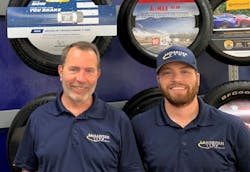The all-weather tire category has significant growth potential, according to a number of tire dealers who sell the products.
Howie Fetzer, president of Fetzer Tire Automotive Repair Service in Southport, Conn., says his dealership’s all-weather tire sales have been multiplying year after year.
Fetzer reports that his dealership began selling all-weather products 20 years ago, when Nokian Tyres plc, one of his suppliers, introduced its first offering in the then-fledgling category. “In the very beginning, all-weather tires were a small percentage of our annual sales. Now they’re probably close to 85% of our total sales.”
Guiding the conversation
The secret to selling all-weather tires is education, says Fetzer. He often starts the conversation with customers by discussing the differences between traditional all-season tires and all-weather tires and why he believes that the term all-season “is misleading.
“As we like to say when talking with customers, all-season is a marketing term. There are standards that a tire must meet in order to earn an all-weather rating.
“All-weather tires have that severe service emblem with the ability to run year-round, so you don’t have to switch back and forth between two sets of tires,” he tells them.
“When our customers understand they can have a product that meets the demands of the weather conditions we experience (in Connecticut), they’re all over it.”
The Nokian WR G4 all-weather tire is prominently featured on Fetzer Tire’s website. His showroom displays that promote Nokian all-weather products are hard to miss.
“The Nokian product has been such a fantastic tire over the years that our customers want them. That’s what they come in asking for."
It’s just not the convenience of owning one set of tires that appeals to customers, he notes. “They see the performance difference.”
In fact, one of Fetzer’s customers recently told him he was worried that his new all-weather tires would over-perform. “This is a true story. Nokian has a 30-day test trial period. I recently had the first person in eight to 10 years take me up on it.”
The customer returned to Fetzer’s store and the “complaint was that the tires gripped too well! When I submitted the paperwork to Nokian, I listed that as the reason.”
A representative from Nokian contacted Fetzer, questioning the note. “I said that I wasn’t joking around. The gentleman was concerned that the tires gripped so well that if he made a quick maneuver, his car would flip over.”
Fetzer says not all of his customers are candidates for all-weather tires.
“We’re in an area where if people can afford it, they go south for the winter. If that’s the case, this is not the type of tire we’re going to recommend.
“We have customers who go to the mountains in Vermont and New Hampshire every weekend. If that’s the case, we say, ‘You should have a designated winter tire for that.’
“But where we are, it’s a combination of dry roads, wet roads, slushy roads and snowy roads. Most of our customers need something that will meet all of those conditions. They want to make sure they’re safe.”
Fetzer says he sees nothing but growth for the all-weather category “for a number of reasons. One, as more manufacturers offer the product, retailers have more options. It’s hard to grow a market if there’s no product to sell.
“And I think that once the consumer starts experiencing the differences between all-season and all-weather tires, they’re going to want all-weather tires — if they live in areas that experience winter conditions.
“The analogy I like to use with customers is, ‘Think of the tires on your car as the shoes you wear. It doesn’t make a difference what physical shape you’re in. Your traction level is based on the shoes you’re wearing. An all-season tire is like a sneaker, whereas an all-weather tire is like putting a boot on your foot.’
Personal experience
“We have a showroom that’s full of different tires,” says Joe Peter, who owns Joe’s Auto & Tire, a dealership with one location in Rochester, Minn., and another in Winona, Minn.
“Consumers think they’re all round and black and have some kind of tread configuration on them. But an all-weather tread looks so much different than a conventional all-season tread. Customers can see the tread blocks. They can see the larger voids.”
Peter tells customers they can put an all-season tire on their vehicle “and drive (through) all four seasons OK. But they can put on an all-weather tire and drive through all four seasons and have a higher level of confidence and safety in winter conditions.
“We qualify customers with good questions and really focus on the question of how important winter traction and safety are to them,” says Peter. “I think it’s pretty hard for the customer to tell you neither is important.”
If there’s hesitation, “we put (customers) on a 90-day trial and tell them, ‘If the tires aren’t what you expect, you can return them and get a different product.’”
Peter admits that all-weather tires can be “a bit of a compromise for people who are running dedicated winter tires and switch them out in the spring.
“But this gives people who one, can’t afford (winter tires), and two, don’t have storage for winter tires, an alternative.”
The Firestone WeatherGrip has been a big seller for Joe’s Auto & Tire, says Peter. “We sell the Toyo Celsius, as well. And we’ve sold Goodyear’s (all-weather) product.”
When Bridgestone Americas Inc. introduced the Firestone WeatherGrip several years ago, “it rolled out in late-spring. We immediately started selling it. We had two quarters of sales before winter even hit that year.
“The bulk of our tire sales are in the beginning of the third quarter through the beginning of the fourth quarter because it’s winter weather-driven.
“People know (bad weather) is going to happen. At that point, it’s pretty easy to show them” the benefits of all-weather tires.
“The other thing is that car manufacturers are making vehicles more manageable in the winter with traction control, stability control and other enhancements,” adds Peter.
“The cars behave like they should, no matter who’s driving them. And if you can add even more traction, for most people, it’s an improvement. People are concerned (about safety) going into winter and that’s when these tires really shine.”
There will always be a place for dedicated winter tires, he explains. “We still have (owners of) family cars — like small SUVs or CUVs — who want maximum traction and want the benefit of having a dedicated winter tire.”
But as more manufacturers “either have an all-weather tire or come out with one,” the category will continue to grow. “I think the product will become more common.”
Qualifying the customer
Over in Minnetonka, Minn., Chris Mortenson, the owner of Samaritan Tire Co. - which also has a location in Edina, Minn. - expects the all-weather tire segment to grow rapidly. In fact, he says, all-weather tires may edge out all-season tires in his market down the line.
“I think in this climate, where winters are brutal, all-weather will probably overtake all-season at some point. I think there’s good potential for that.”
In the meantime, Samaritan Tire continues to push a variety of all-weather tires built by various tire manufacturers. The General AltiMax365AW, which is produced by Continental Tire the Americas LLC, has been a big seller at the dealership says Mortenson.
The all-weather sales process at his company starts like most others, he explains.
“Most customers come in and say, ‘I need tires for my car.’ “We’re going to look at the car, see what they have and make recommendations from there.”
If customers’ existing tires are no longer adequate for Minnesota winter driving, Mortenson and his salespeople will ask customers if they want “a better-traction tire.”
If the answer is yes, Mortenson’s team will insert all-weather tires into the conversation. “We explain that these tires are going to work better (in severe conditions) than all-season tires - not as good as winter tires, but the next best thing.
“Now if they say, ‘I go to Florida for the winter each year,’ we might not approach it the same way,” says Mortenson. “But if they’re up here all year — and they don’t want to switch out summer and winter tires — we’ll recommend all-weather tires.”
Next, the Samaritan Tire sales team will walk customers over to the dealership’s tire wall, which displays all-weather tires next to all-season tires.
The idea is to show customers the differences in the products’ tread designs and other features.
“People want to see what they’re buying. It makes a difference. I know the way of the world now is that everything’s (online), but our customers want to actually see tires” before buying them.
The 3-Peak Mountain Snowflake designation is another selling point, according to Mortenson. “We explain that it’s like what a winter tire would have. That’s critical. People are very receptive to that.”
'It's our job to educate'
Brad Estes, regional manager for The Dalles, Ore.-based Gill’s Point S Tire, is responsible for seven retail stores and one distribution center in central and southern Oregon. He says all-weather tires have become “really popular as of late” in his area as more manufacturers offer them.
“People like the flexibility of not having to jump back and forth between an all-season tire and a studded winter tire.”
Some customers prefer the extra traction of a studded or dedicated winter tire, he explains. “People love the security they provide. I know I do. I live in snow country, so I run studs on my vehicle.”
But customers who aren’t obvious candidates for winter tires can be steered toward all-weather tires - if they’re asked the right questions, according to Estes.
Matching the right tire to the right vehicle “is our job as tire dealers. Sometimes people come in and say, ‘My tire is M+S-rated.’ Or all they know is the tire is black, round and rolls.
“You have to ask qualifying questions like ‘Where are you driving your vehicle? How are you driving it? Are you sticking to driving on pavement? Are you going to be in snow country?’ You have to dig a little deeper. It’s our job to educate customers on the differences.”
About the Author
Mike Manges
Editor
Mike Manges is Modern Tire Dealer’s editor. A 28-year tire industry veteran, he is a three-time International Automotive Media Association Award winner, holds a Gold Award from the Association of Automotive Publication Editors and was named a finalist for the prestigious Jesse H. Neal Award, the Pulitzer Prize of business-to-business media, in 2024. He also was named Endeavor Business Media's Editor of the Year in 2024. Mike has traveled the world in pursuit of stories that will help independent tire dealers move their businesses forward. Before rejoining MTD in 2019, he held corporate communications positions at two Fortune 500 companies and served as MTD’s senior editor from 2000 to 2010.

